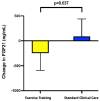Serum Fibroblast Growth Factor 21 Is Markedly Decreased following Exercise Training in Patients with Biopsy-Proven Nonalcoholic Steatohepatitis
- PMID: 36986211
- PMCID: PMC10056327
- DOI: 10.3390/nu15061481
Serum Fibroblast Growth Factor 21 Is Markedly Decreased following Exercise Training in Patients with Biopsy-Proven Nonalcoholic Steatohepatitis
Abstract
Background and aims: Exercise remains a key component of nonalcoholic fatty liver disease (NAFLD) treatment. However, mechanisms underpinning the improvements in NAFLD seen with exercise are unclear. Exercise improved liver fat and serum biomarkers of liver fibrosis in the NASHFit trial. We investigated exercise's mechanism of benefit by conducting a post hoc analysis of these data to determine the relationship between serum fibroblast growth factor (FGF) 21, which is implicated in NAFLD development, and exercise.
Methods: In the 20 wk NASHFit trial, patients with nonalcoholic steatohepatitis (NASH) were randomized to receive moderate-intensity aerobic exercise training or standard clinical care. Mediterranean-informed dietary counseling was provided to each group. Change in serum FGF21 was measured after an overnight fast.
Results: There was a significant improvement in serum FGF21 with exercise training compared to standard clinical care (p = 0.037) with serum FGF21 reducing by 22% (-243.4 +/-349 ng/mL) with exercise vs. a 34% increase (+88.4 ng/mL +/-350.3 ng/mL) with standard clinical care. There was a large inverse association between change in serum FGF21 and change in cardiorespiratory fitness (VO2peak) (r = -0.62, 95% CI -0.88 to -0.05, p = 0.031), and on multivariable analysis, change in VO2peak remained independently associated with change in FGF21 (β = -44.5, 95% CI -83.8 to -5.11, p = 0.031).
Conclusions: Serum FGF21 is markedly decreased in response to aerobic exercise training, offering a novel mechanism to explain the observed reduction in liver fat and improvement in serum biomarkers of liver fibrosis in patients with NASH who do exercise.
Keywords: biomarker; cardiorespiratory fitness; fatty liver; nonalcoholic fatty liver disease; physical activity.
Conflict of interest statement
J.G.S. receives or has received research support from AstraZeneca, Galectin, Noom, Inc., Novo Nordisk, and Zydus. RL serves as a consultant or advisory board member for Arrowhead Pharmaceuticals, AstraZeneca, Bird Rock Bio, Boehringer Ingelheim, Bristol-Myer Squibb, Celgene, Cirius, CohBar, Conatus, Eli Lilly, Galmed, Gemphire, Gilead, Glympse bio, GNI, GRI Bio, Intercept, Ionis, Janssen Inc., Merck, Metacrine, Inc., NGM Biopharmaceuticals, Novartis, Novo Nordisk, Pfizer, Prometheus, Sanofi, Siemens, and Viking Therapeutics. In addition, his institution has received grant support from Allergan, Boehringer-Ingelheim, Bristol-Myers Squibb, Cirius, Eli Lilly and Company, Galectin Therapeutics, Galmed Pharmaceuticals, GE, Genfit, Gilead, Intercept, Grail, Janssen, Madrigal Pharmaceuticals, Merck, NGM Biopharmaceuticals, NuSirt, Pfizer, pH Pharma, Prometheus, and Siemens. He is also the co-founder of Liponexus, Inc. All other authors have no relevant conflicts of interest to report.
Figures


Similar articles
-
Hepatoprotective effects of the long-acting fibroblast growth factor 21 analog PF-05231023 in the GAN diet-induced obese and biopsy-confirmed mouse model of nonalcoholic steatohepatitis.Am J Physiol Gastrointest Liver Physiol. 2023 May 1;324(5):G378-G388. doi: 10.1152/ajpgi.00157.2022. Epub 2023 Feb 28. Am J Physiol Gastrointest Liver Physiol. 2023. PMID: 36852934
-
Exercise training improves serum biomarkers of liver fibroinflammation in patients with metabolic dysfunction-associated steatohepatitis.Liver Int. 2024 Feb;44(2):532-540. doi: 10.1111/liv.15769. Epub 2023 Nov 28. Liver Int. 2024. PMID: 38014619 Free PMC article. Clinical Trial.
-
Association between Serum Atypical Fibroblast Growth Factors 21 and 19 and Pediatric Nonalcoholic Fatty Liver Disease.PLoS One. 2013 Jun 26;8(6):e67160. doi: 10.1371/journal.pone.0067160. Print 2013. PLoS One. 2013. PMID: 23840612 Free PMC article.
-
Exercise Is Medicine for Nonalcoholic Fatty Liver Disease: Exploration of Putative Mechanisms.Nutrients. 2023 May 24;15(11):2452. doi: 10.3390/nu15112452. Nutrients. 2023. PMID: 37299416 Free PMC article. Review.
-
Fibroblast Growth Factors for Nonalcoholic Fatty Liver Disease: Opportunities and Challenges.Int J Mol Sci. 2023 Feb 26;24(5):4583. doi: 10.3390/ijms24054583. Int J Mol Sci. 2023. PMID: 36902015 Free PMC article. Review.
Cited by
-
The effects of exercise on FGF21 in adults: a systematic review and meta-analysis.PeerJ. 2024 Jun 25;12:e17615. doi: 10.7717/peerj.17615. eCollection 2024. PeerJ. 2024. PMID: 38948228 Free PMC article.
-
Prevention of liver cancer in the era of next-generation antivirals and obesity epidemic.Hepatology. 2025 Jan 14:10.1097/HEP.0000000000001227. doi: 10.1097/HEP.0000000000001227. Online ahead of print. Hepatology. 2025. PMID: 39808821 Free PMC article.
-
AMPED study: Protocol for a randomized controlled trial of different doses of aerobic exercise training.Hepatol Commun. 2024 Jun 19;8(7):e0464. doi: 10.1097/HC9.0000000000000464. eCollection 2024 Jul 1. Hepatol Commun. 2024. PMID: 38896071 Free PMC article.
-
Effects of Mediterranean diet, exercise, and their combination on body composition and liver outcomes in metabolic dysfunction-associated steatotic liver disease: a systematic review and meta-analysis of randomized controlled trials.BMC Med. 2025 Aug 27;23(1):502. doi: 10.1186/s12916-025-04320-7. BMC Med. 2025. PMID: 40866968 Free PMC article.
-
Skeletal muscle and MASLD: Mechanistic and clinical insights.Hepatol Commun. 2025 May 23;9(6):e0711. doi: 10.1097/HC9.0000000000000711. eCollection 2025 Jun 1. Hepatol Commun. 2025. PMID: 40408301 Free PMC article. Review.
References
-
- Kim D., Murag S., Cholankeril G., Cheung A., Harrison S.A., Younossi Z.M., Ahmed A. Physical Activity, Measured Objectively, Is Associated with Lower Mortality in Patients with Nonalcoholic Fatty Liver Disease. Clin. Gastroenterol. Hepatol. Off. Clin. Pract. J. Am. Gastroenterol. Assoc. 2021;19:1240–1247.e1245. doi: 10.1016/j.cgh.2020.07.023. - DOI - PubMed
-
- Chalasani N., Younossi Z., Lavine J.E., Charlton M., Cusi K., Rinella M., Harrison S.A., Brunt E.M., Sanyal A.J. The Diagnosis and Management of Nonalcoholic Fatty Liver Disease: Practice Guidance from the American Association for the Study of Liver Diseases. Hepatology. 2017;67:328–357. doi: 10.1002/hep.29367. - DOI - PubMed

